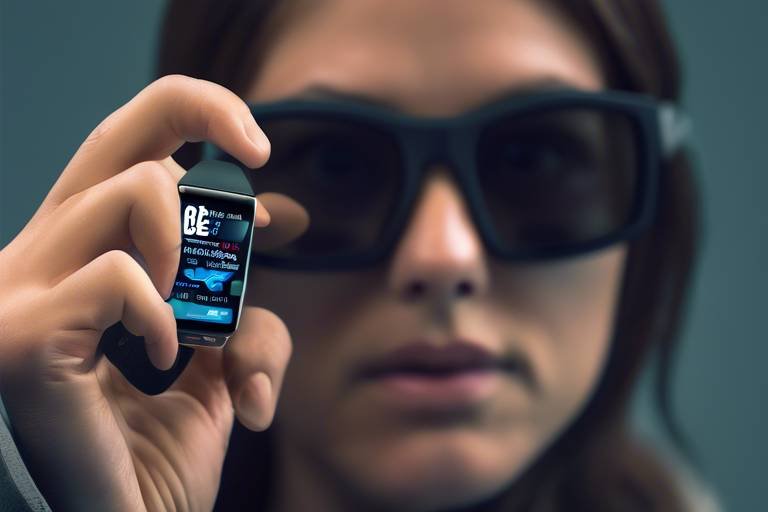The Future of Wearable Technology in Health Monitoring
As we step into an era where technology intertwines seamlessly with our daily lives, wearable technology is emerging as a game-changer in the realm of health monitoring. Imagine having a personal health assistant right on your wrist, constantly tracking your vital signs, activity levels, and even your sleep patterns. It's not just a dream anymore; it's a reality that is evolving at breakneck speed. The advancements in this field are not just about convenience; they are fundamentally reshaping how we approach health and wellness.
Wearable devices such as smartwatches, fitness bands, and even smart clothing are equipped with sophisticated sensors that collect and analyze health data in real-time. This capability allows users to gain insights into their health like never before. Think of it as having a window into your body, providing feedback that can help you make informed decisions about your lifestyle and healthcare. With features like heart rate monitoring, blood oxygen levels, and even ECG readings, these devices are becoming indispensable tools for proactive health management.
However, the future of wearable technology in health monitoring is not without its challenges. As beneficial as these devices are, they raise questions about data privacy and the accuracy of the information they provide. Users must navigate the balance between leveraging technology for health benefits and ensuring their personal information remains secure. Moreover, as the technology becomes more advanced, ensuring that the data collected is accurate and reliable is paramount for both users and healthcare providers.
In the coming years, we can expect to see an explosion of innovation in this sector. With the integration of artificial intelligence (AI) and machine learning, wearables will not only track health metrics but also analyze and predict health trends. This could lead to personalized health insights that are tailored to individual needs, making health monitoring not just reactive but also proactive. Imagine a wearable that can predict a potential health issue before it becomes critical, allowing for timely intervention and potentially saving lives.
As we look to the future, the potential applications of wearable technology in health monitoring seem limitless. From managing chronic diseases to enhancing overall fitness and wellness, the impact of these devices on our health landscape will be profound. The journey has just begun, and as technology continues to advance, we can only anticipate how these innovations will transform our approach to health and well-being.
- What types of health metrics can wearables track? Wearable devices can track a variety of health metrics, including heart rate, sleep patterns, physical activity, blood oxygen levels, and more.
- Are wearable health devices accurate? While many wearable devices are quite accurate, it's essential to choose reputable brands and understand that they are not a substitute for professional medical advice.
- How do wearables enhance chronic disease management? Wearables provide continuous monitoring and alerts, helping patients and healthcare providers manage chronic diseases more effectively.
- What role does AI play in wearable technology? AI enhances the capabilities of wearables by enabling predictive analytics and personalized health insights, making health monitoring more effective.

Current Trends in Wearable Health Devices
Wearable health devices are not just a trend; they are revolutionizing the way we monitor our health. With technology advancing at lightning speed, these devices are becoming more sophisticated, user-friendly, and integrated into our daily lives. Imagine a world where your wristband not only tracks your steps but also monitors your heart rate and even detects irregularities that could indicate a health issue. That world is here, and it’s evolving rapidly!
One of the most exciting trends is the integration of advanced sensors into wearable devices. These sensors can measure a variety of health metrics such as blood oxygen levels, sleep patterns, and even stress levels. For instance, devices like the latest smartwatches come equipped with electrocardiogram (ECG) capabilities, allowing users to take heart readings on the go. The ability to gather such comprehensive data is a game changer for both users and healthcare professionals.
Moreover, the rise of health-focused apps that sync with these devices is enhancing user experience. These apps provide personalized insights based on the data collected, helping users understand their health better. For example, if a user’s heart rate spikes during a workout, the app can suggest modifications to their routine or alert them to potential health risks. This level of personalization is what sets modern wearables apart from their predecessors.
Another noteworthy trend is the shift towards interoperability. Wearable devices are increasingly designed to work seamlessly with other health technologies, such as electronic health records (EHR) and telehealth platforms. This integration ensures that health data flows smoothly between devices and healthcare providers, which can lead to better patient outcomes. Imagine your doctor receiving real-time data from your wearable device during a telehealth appointment—this could significantly enhance the quality of care you receive.
Additionally, the focus on user engagement is becoming a central theme in wearable technology. Companies are recognizing that for wearables to be effective, users must be motivated to use them consistently. Features like gamification—where users earn rewards for achieving health goals—are becoming increasingly popular. This not only makes health monitoring fun but also encourages users to maintain healthier lifestyles.
As we look towards the future, it's clear that the landscape of wearable health devices is expanding rapidly. With advancements in technology and a growing awareness of health and wellness, the potential for these devices is limitless. The combination of real-time data collection, personalized insights, and improved interoperability will undoubtedly lead to a more proactive approach to health management.
In conclusion, the current trends in wearable health devices are shaping a new era of health monitoring. From advanced sensors to engaging apps, these innovations are making it easier for individuals to take charge of their health. As technology continues to advance, we can only expect these devices to become even more integral to our daily lives.

Benefits of Wearable Technology for Health Monitoring
Wearable technology has revolutionized the way we approach health monitoring, bringing a plethora of benefits that can significantly enhance our well-being. Imagine having a personal health assistant right on your wrist—this is the reality that wearables offer today. From tracking daily activities to monitoring vital signs, these devices empower users to take charge of their health like never before. One of the most remarkable advantages of wearable technology is real-time data tracking. With continuous monitoring, users can keep an eye on their heart rate, sleep patterns, and even stress levels, providing them with immediate insights into their health status.
Furthermore, the ability to collect and analyze data in real-time means that individuals can receive personalized insights tailored to their unique health profiles. For instance, if a wearable device detects an irregular heartbeat, it can alert the user and suggest actions to mitigate potential health risks. This level of personalization not only helps users make informed decisions but also fosters a deeper understanding of their health journeys. In essence, wearables transform data into actionable insights, making health management more intuitive and user-friendly.
Another significant benefit is the improved patient engagement that wearables facilitate. By actively involving users in their health monitoring, these devices encourage a sense of responsibility and motivation. Users can set fitness goals, track their progress, and celebrate achievements, creating a positive feedback loop that promotes healthier lifestyle choices. For example, a user might set a daily step goal, and as they receive notifications on their progress, they become more inclined to stay active. This shift in mindset is crucial for long-term health improvement.
Moreover, wearable technology has proven invaluable in managing chronic diseases. Devices equipped with sensors can continuously monitor conditions such as diabetes or hypertension, providing both patients and healthcare providers with critical data. This constant stream of information allows for timely interventions and adjustments to treatment plans. For instance, a diabetic patient can receive alerts if their blood sugar levels fluctuate, enabling them to take necessary actions before complications arise. This proactive approach to healthcare not only enhances patient outcomes but also reduces the burden on healthcare systems.
To summarize, the benefits of wearable technology in health monitoring are profound and multifaceted. They empower users through:
- Real-Time Data Tracking: Continuous monitoring of vital signs.
- Personalized Insights: Tailored health recommendations based on individual data.
- Improved Patient Engagement: Encouraging active participation in health management.
- Chronic Disease Management: Constant monitoring for timely interventions.
As we look to the future, it's clear that wearable technology will continue to evolve, offering even more sophisticated features that enhance our health monitoring capabilities. The integration of advanced technologies, such as AI and predictive analytics, will only serve to amplify these benefits, making health monitoring more effective and accessible for everyone.

Real-Time Data Collection
Imagine having a personal health assistant strapped to your wrist, constantly monitoring your body’s vital signs. This is the reality that wearable technology has ushered in with its capabilities. Unlike traditional health monitoring methods that require periodic check-ups, wearables provide continuous insights into various health metrics such as heart rate, sleep patterns, and physical activity levels. This seamless flow of information empowers users to take control of their health in ways that were previously unimaginable.
One of the most significant advantages of real-time data collection is the ability to detect potential health issues before they escalate. For example, if a wearable device notices an irregular heartbeat, it can alert the user, prompting them to seek medical attention. This proactive approach not only enhances individual health management but also alleviates the burden on healthcare systems by potentially reducing emergency visits.
Moreover, the data collected in real-time can be incredibly detailed. Wearable devices often come equipped with sensors that track:
- Heart Rate Variability: Understanding how your heart responds to stress can be crucial for managing anxiety and improving overall wellness.
- Blood Oxygen Levels: Monitoring oxygen saturation can help in managing respiratory conditions.
- Sleep Quality: Insights into your sleep cycles can lead to better rest and recovery strategies.
- Physical Activity: Tracking daily movements encourages a more active lifestyle.
However, the benefits of real-time data collection extend beyond just individual users. Healthcare providers can leverage this information to tailor treatment plans and interventions. For instance, doctors can access patients' data remotely, allowing them to monitor progress and make informed decisions without requiring the patient to visit the clinic. This shift not only enhances patient engagement but also fosters a collaborative approach to healthcare.
As we look to the future, it’s clear that real-time data collection through wearable technology will play a pivotal role in the evolution of health monitoring. With advancements in connectivity, such as 5G, the speed and reliability of data transmission will only improve, making it easier for users and healthcare professionals to stay connected. The combination of real-time data and advanced analytics will pave the way for a more personalized healthcare experience, where interventions can be tailored to the individual’s unique health profile.
In summary, real-time data collection is revolutionizing health monitoring by providing continuous, actionable insights that empower users and healthcare providers alike. The ability to track health metrics in real-time not only enhances individual health management but also contributes to a more efficient healthcare system. As technology continues to advance, we can expect even more sophisticated solutions that will further enhance the way we monitor and manage our health.
Q: How accurate are the health metrics collected by wearable devices?
A: While wearable devices have improved significantly in accuracy, it's essential to remember that they can sometimes provide estimates rather than precise measurements. It's always a good idea to consult healthcare professionals for critical health assessments.
Q: Can wearable devices help in managing chronic illnesses?
A: Absolutely! Wearable devices can continuously monitor vital signs and alert users to any concerning changes, making them valuable tools for managing chronic conditions such as diabetes or heart disease.
Q: Are there privacy concerns associated with wearable health technology?
A: Yes, privacy is a significant concern. Users should ensure that they understand how their data is being collected, stored, and shared. Opting for devices with strong data protection measures can help mitigate these risks.
Q: How can I choose the right wearable device for my health needs?
A: When selecting a wearable device, consider what health metrics are most important to you, your budget, and the compatibility with other health apps or devices you may be using. Reading reviews and seeking recommendations can also help in making an informed choice.

Impact on Chronic Disease Management
Wearable devices have revolutionized the way we approach chronic disease management. Imagine having a personal health assistant that not only tracks your vital signs but also alerts you to potential health issues before they escalate. That's precisely what these devices offer. By continuously monitoring metrics such as heart rate, blood pressure, and glucose levels, wearables empower patients to take charge of their health in ways that were previously unimaginable.
One of the most significant advantages of wearables in chronic disease management is their ability to provide real-time alerts. For instance, if a patient's heart rate spikes beyond a certain threshold, the device can send an immediate notification to the user and even alert healthcare providers. This proactive approach can drastically reduce the risk of emergencies and hospitalizations, allowing for timely interventions that can save lives.
Moreover, wearables facilitate remote patient monitoring, enabling healthcare professionals to keep an eye on their patients without the need for frequent office visits. This is particularly beneficial for those with chronic conditions, such as diabetes or hypertension, who require regular check-ups. With wearables, doctors can access up-to-date health data, enabling them to make informed decisions about treatment plans. This not only enhances patient care but also fosters a stronger patient-provider relationship, as patients feel more engaged and involved in their health management.
Additionally, the data collected by these devices can be analyzed to identify trends and patterns in a patient's health over time. For example, a diabetic patient can track their blood sugar levels and correlate them with their diet and exercise habits. This level of insight allows for personalized treatment plans, tailored to the individual's specific needs. By understanding how different factors influence their health, patients can make more informed lifestyle choices, leading to better overall health outcomes.
However, it's essential to address the potential challenges that come with integrating wearables into chronic disease management. Issues such as data privacy and security must be taken seriously, as sensitive health information is being transmitted and stored. Therefore, both manufacturers and users must prioritize data protection to ensure that this valuable information remains confidential.
In conclusion, the impact of wearable technology on chronic disease management is profound. From real-time monitoring and alerts to personalized insights and remote patient care, these devices are not just gadgets; they are lifelines for many individuals managing chronic conditions. As technology continues to advance, the potential for wearables to enhance health outcomes will only grow, paving the way for a healthier future.
- What types of chronic diseases can be managed with wearable technology? Wearable devices can help manage various chronic diseases, including diabetes, heart disease, asthma, and hypertension.
- Are wearable devices accurate in monitoring health metrics? While most wearable devices provide fairly accurate data, it's essential to consult healthcare professionals for comprehensive assessments.
- How can I ensure my health data is secure? Use devices with strong encryption, regularly update software, and be cautious about sharing your data with third-party applications.
- Can wearables replace regular doctor visits? While wearables enhance monitoring, they are not a substitute for regular medical consultations. They should complement traditional healthcare.

Enhancing Fitness and Lifestyle
In today's fast-paced world, where every second counts, maintaining a healthy lifestyle can often feel like an uphill battle. Enter wearable technology—your personal fitness assistant that fits right on your wrist. These devices are not just trendy accessories; they are powerful tools that empower you to take charge of your health. Imagine having a coach, a motivator, and a health tracker all rolled into one sleek gadget. That's the magic of wearables!
At the heart of this transformation is the ability of wearable devices to track a variety of fitness metrics in real-time. From heart rate and calories burned to steps taken and sleep quality, these gadgets provide a comprehensive snapshot of your health. But how does this translate into a better lifestyle? Well, let's break it down.
First off, wearables encourage goal-setting. When you can visualize your progress—whether it's achieving a daily step count or burning a certain number of calories—it becomes easier to stay motivated. Many devices even allow you to set reminders to move, drink water, or take breaks, nudging you towards healthier habits. It's like having a personal trainer whispering in your ear, "You've got this!"
Moreover, the social aspect of fitness is amplified through these devices. Many wearables come with built-in social features that allow you to connect with friends or join challenges. This sense of community can be a game-changer. When you see your friends achieving their fitness goals, it ignites a competitive spirit that can push you to do better. After all, who doesn’t want to be the friend who logs the most steps?
Another exciting feature is the integration of fitness apps that work seamlessly with wearable devices. These apps often provide personalized workout plans, nutrition tracking, and even mindfulness exercises. The result? A holistic approach to health that goes beyond just physical fitness. With the right app, you can track your meals, monitor your hydration, and even practice meditation—all while keeping your wearable device close.
But wait, there's more! Many wearables now include advanced features like heart rate variability monitoring and stress tracking. This means you can not only improve your physical health but also take care of your mental well-being. Imagine being able to identify when you're feeling stressed and having the tools to manage it effectively. It's like having a wellness coach on your wrist!
To illustrate the impact of wearables on fitness and lifestyle, let's look at a comparison table showcasing some popular devices and their features:
| Device | Heart Rate Monitor | Step Tracking | Sleep Tracking | Social Features |
|---|---|---|---|---|
| Fitbit Charge 5 | Yes | Yes | Yes | Challenges with Friends |
| Apple Watch Series 7 | Yes | Yes | Yes | Activity Sharing |
| Garmin Venu 2 | Yes | Yes | Yes | Group Challenges |
As you can see, the features vary, but the underlying goal is the same: to enhance your fitness journey. With this technology at your fingertips, you're not just tracking data; you're transforming your lifestyle. It’s about making informed decisions, staying active, and ultimately leading a healthier, happier life.
So, are you ready to embrace the future of fitness? With wearables, you're not just keeping up with your health; you're taking it to the next level. It’s time to lace up those sneakers, strap on your device, and get moving!
- What types of metrics can wearables track? Most wearables can track heart rate, steps, sleep quality, and calories burned.
- Can wearables help with weight loss? Yes! They provide insights and reminders that can help you stay on track with your fitness goals.
- Are wearables accurate? While they are generally reliable, accuracy can vary by device and the specific metric being measured.
- Do I need to pay for fitness apps? Many fitness apps are free, but some offer premium features for a fee.

Challenges in Wearable Health Technology
As exciting as the world of wearable health technology is, it’s not without its challenges. One of the most pressing issues is data privacy. With the vast amounts of personal health data being collected by these devices, users often find themselves in a dilemma: how much of their information is safe? The thought of sensitive health metrics being exposed or misused can be daunting. Companies must prioritize robust security measures to protect user data, but many consumers still harbor skepticism about the effectiveness of these measures.
Another significant challenge is accuracy. While many wearable devices claim to provide precise health metrics, the reality can be quite different. Inaccurate readings can lead to misdiagnoses or inappropriate health decisions. For instance, a fitness tracker that inaccurately records heart rates might lead someone to push their limits during a workout, risking their health. Therefore, manufacturers must continuously work on improving the calibration and reliability of their devices to ensure users can trust the data they receive.
Moreover, there’s the issue of user engagement. While some users are enthusiastic about tracking their health, others may feel overwhelmed by the constant influx of data. This can lead to a phenomenon known as information fatigue, where users disengage from their devices altogether. To combat this, developers need to create more intuitive interfaces and provide actionable insights rather than just raw data. Imagine if your wearable not only told you your heart rate but also suggested when to take a break or adjust your workout intensity!
Lastly, the integration of wearable technology with existing healthcare systems poses another hurdle. Many healthcare providers are still adapting to digital records and telemedicine. Ensuring that data from wearables can seamlessly integrate into electronic health records (EHR) is crucial for providing comprehensive patient care. This requires collaboration between tech companies and healthcare professionals to establish standardized protocols.
In summary, while wearable health technology holds immense potential to revolutionize health monitoring, it must overcome these challenges to truly benefit users. Addressing issues of data privacy, accuracy, user engagement, and system integration will be vital for the future success of this innovative technology.
- What are the most common challenges faced by wearable health technology? The most common challenges include data privacy, accuracy of health metrics, user engagement, and integration with healthcare systems.
- How can I ensure my data is secure when using wearable devices? Choose devices from reputable manufacturers that prioritize data security and regularly update their software to address vulnerabilities.
- Are wearable health devices accurate? While many wearables provide reasonably accurate data, it’s essential to be aware that they can sometimes produce inaccurate readings. Always consult a healthcare professional for critical health decisions.
- How can I stay engaged with my wearable device? To maintain engagement, look for wearables that offer personalized insights and actionable recommendations rather than just raw data.

The Role of AI and Machine Learning
Artificial Intelligence (AI) and Machine Learning (ML) are revolutionizing the landscape of wearable technology, particularly in the realm of health monitoring. Imagine a world where your smartwatch not only tracks your steps but also predicts potential health issues before they become critical. This is the power of AI and ML—transforming raw data into actionable insights that can significantly enhance your well-being.
At the heart of this transformation is the ability of AI to analyze vast amounts of data collected by wearable devices. These devices continuously gather information such as heart rate, sleep patterns, and physical activity levels. By employing sophisticated algorithms, AI can sift through this data to identify trends and anomalies. For instance, if your wearable detects a sudden spike in heart rate during a period of rest, it can alert you to potential stress or health issues that may require further investigation.
Moreover, Machine Learning plays a crucial role in personalizing health insights. Unlike traditional health monitoring methods that offer a one-size-fits-all approach, ML algorithms can tailor recommendations based on individual user data. This means that your wearable can provide you with personalized fitness goals, dietary suggestions, and even stress management techniques. The more you use the device, the smarter it becomes, adapting to your unique lifestyle and health needs.
One of the most exciting applications of AI and ML in wearable technology is in the realm of predictive analytics. By analyzing historical data, these technologies can forecast potential health issues before they manifest. This proactive approach to healthcare allows users to take preventive measures, ultimately leading to better health outcomes. For example, if your device predicts a likelihood of developing hypertension based on your activity levels and stress patterns, it can suggest lifestyle changes to mitigate that risk.
However, the integration of AI and ML in health monitoring is not without its challenges. Data privacy concerns loom large, as users may be hesitant to share sensitive health information. Additionally, the accuracy of AI predictions depends heavily on the quality of the data being collected. Therefore, ensuring that wearables collect accurate and reliable data is paramount for the success of these technologies.
As we look to the future, the potential of AI and Machine Learning in wearable health technology is immense. With ongoing advancements in these fields, we can expect to see even more sophisticated health monitoring solutions that not only keep us informed but also empower us to take charge of our health. By harnessing the power of AI and ML, wearable devices could soon become indispensable tools in our quest for a healthier lifestyle.
- How does AI improve wearable health technology?
AI enhances wearable health technology by analyzing vast amounts of data to provide personalized insights and predictive analytics, helping users manage their health more effectively. - What are the privacy concerns associated with wearable health devices?
Privacy concerns mainly revolve around the collection and storage of sensitive health data, which could be vulnerable to breaches if not adequately protected. - Can wearables predict health issues?
Yes, wearables equipped with AI and ML can analyze data trends to predict potential health issues, allowing for proactive health management.

Predictive Analytics in Health Monitoring
Predictive analytics is revolutionizing the landscape of health monitoring by leveraging data from wearable devices to forecast potential health issues before they manifest. Imagine having a personal health assistant that not only tracks your daily activities but also predicts when you might be at risk for certain conditions. This is the power of predictive analytics, and it’s becoming more accessible thanks to advancements in technology.
By analyzing patterns in the data collected from wearables, such as heart rate, sleep quality, and activity levels, predictive analytics can identify trends that might indicate an impending health crisis. For instance, if a user’s heart rate consistently spikes during sleep, this could signal underlying health issues like sleep apnea or cardiovascular problems. The ability to catch these warning signs early can lead to timely interventions, potentially saving lives and reducing healthcare costs.
One of the most exciting aspects of predictive analytics is its ability to personalize health recommendations. For example, if a wearable device notices that a user’s physical activity decreases significantly during certain times of the year, it can suggest tailored fitness plans or reminders to encourage more movement. This level of personalization not only enhances user engagement but also empowers individuals to take charge of their health.
Furthermore, healthcare providers can utilize predictive analytics to improve patient outcomes. By integrating data from multiple patients, they can identify broader trends that may not be visible on an individual level. This can lead to more effective treatment plans and preventive measures. For example, if a healthcare provider notices a rise in certain symptoms among patients using a specific wearable device, they can investigate further and take action, potentially preventing a larger health issue from developing.
However, the implementation of predictive analytics in health monitoring is not without its challenges. Data privacy concerns are paramount, as users must trust that their sensitive health information is being handled securely. Additionally, the accuracy of predictions relies heavily on the quality of the data collected. Inaccurate data can lead to false alarms or missed opportunities for intervention. Therefore, it’s crucial for developers and healthcare providers to prioritize data integrity and user privacy.
In summary, predictive analytics is a game-changer in health monitoring, offering the potential for early detection of health issues and personalized health insights. As technology continues to evolve, we can expect even more innovative solutions that will empower individuals and healthcare providers alike. The future of health monitoring is not just about tracking data; it’s about understanding it and using it to foster a healthier society.
- What is predictive analytics in health monitoring?
Predictive analytics in health monitoring involves using data from wearable devices to forecast potential health issues, enabling early intervention and personalized health recommendations.
- How can wearable devices improve health outcomes?
Wearable devices can continuously monitor vital health metrics, allowing for real-time data analysis and timely interventions to improve overall health outcomes.
- Are there privacy concerns with wearable health technology?
Yes, data privacy is a significant concern. Users must ensure their health information is securely handled to maintain trust in wearable technology.
- Can predictive analytics replace traditional healthcare methods?
While predictive analytics enhances traditional methods by providing additional insights, it is not a replacement. It should be used in conjunction with professional healthcare advice.

Personalized Health Insights
In an age where health is becoming increasingly individualized, provided by wearable technology are revolutionizing how we approach our well-being. Imagine having a personal health coach on your wrist, one that understands your unique body metrics, lifestyle choices, and even your emotional state. With the integration of advanced algorithms and user data, wearables can generate insights that are not just generic recommendations but tailored advice that fits your specific health profile.
These devices collect a wealth of data, including heart rate, sleep patterns, activity levels, and even stress indicators. This data is then analyzed using sophisticated algorithms to deliver personalized feedback. For instance, if your wearable detects that your heart rate spikes during certain activities, it can suggest modifications to your routine. Or, if it notices that you’re not getting enough sleep, it might recommend a bedtime routine to improve your rest. This level of customization is what sets wearable technology apart from traditional health monitoring methods.
Moreover, the insights gained from these devices can lead to significant lifestyle changes. Users can receive alerts about their health metrics, prompting them to take action before minor issues escalate into serious concerns. For example, a wearable might notify you when your blood pressure readings are higher than usual, encouraging you to consult a healthcare provider or adjust your diet and exercise regimen accordingly. This proactive approach empowers individuals to take charge of their health, fostering a sense of ownership and responsibility.
Additionally, the ability to track progress over time is invaluable. Users can see how their health metrics improve with consistent effort, reinforcing positive behaviors. To illustrate this, consider the following table that summarizes how personalized insights can influence user behavior:
| Health Metric | Personalized Insight | Behavior Change |
|---|---|---|
| Heart Rate | Alerts when elevated during workouts | Adjusts workout intensity |
| Sleep Quality | Recommends sleep hygiene practices | Implements bedtime routines |
| Daily Steps | Encourages reaching daily step goals | Increases physical activity |
What’s exciting is that as technology advances, the potential for even deeper personalization grows. Future wearables could analyze genetic data or integrate with other health apps to provide a comprehensive view of an individual’s health landscape. This could lead to insights that are not just based on current metrics but also predictive in nature, helping users to avoid health issues before they arise. In essence, the future of personalized health insights is not just about tracking metrics; it’s about understanding the whole person.
In conclusion, personalized health insights from wearables are not just a trend; they represent a fundamental shift in how we approach health and wellness. By leveraging real-time data, users can make informed decisions that lead to healthier lifestyles and improved health outcomes. As we look to the future, the integration of AI and data analytics in wearables promises to enhance these insights, making health monitoring more intuitive and effective than ever before.
- What types of data do wearable devices collect? Wearable devices can collect various data types, including heart rate, sleep patterns, physical activity levels, and stress indicators.
- How do personalized health insights benefit users? They provide tailored recommendations that help users make informed decisions about their health, encouraging proactive management and lifestyle changes.
- Can wearables predict health issues? Yes, advanced wearables utilize predictive analytics to anticipate potential health issues based on historical data and current metrics.
- Are personalized insights secure? Data security is a major concern; reputable wearable manufacturers prioritize user privacy and data protection.
Frequently Asked Questions
- What are wearable health devices?
Wearable health devices are gadgets that you can wear on your body, like smartwatches or fitness trackers. They monitor various health metrics such as heart rate, steps taken, sleep patterns, and more, providing real-time data to help you stay on top of your health.
- How do wearable devices improve health monitoring?
These devices continuously collect health data, allowing for real-time tracking of vital signs. This instant feedback helps users make informed decisions about their health and wellness, promoting proactive management of health conditions.
- Can wearable technology help manage chronic diseases?
Absolutely! Wearables can provide constant monitoring for conditions like diabetes or heart disease. They alert users and healthcare providers about any concerning changes, facilitating timely interventions and better management of chronic conditions.
- What are the benefits of using wearable technology for fitness?
Wearable tech motivates users by tracking fitness activities, setting goals, and providing personalized insights. It encourages individuals to maintain a healthier lifestyle through data-driven motivation and accountability.
- Are there any privacy concerns with wearable health devices?
Yes, privacy is a significant concern. Users should be aware of how their data is collected, stored, and shared. It's crucial to choose devices from reputable manufacturers that prioritize data security and user privacy.
- How does AI enhance wearable health technology?
AI and Machine Learning analyze vast amounts of data collected from wearables to provide smarter health insights. They can identify patterns and predict potential health issues, making health monitoring more effective and personalized.
- What is predictive analytics in health monitoring?
Predictive analytics involves using data to anticipate health problems before they occur. By analyzing trends and changes in health metrics, wearables can alert users about potential risks, enabling preventive healthcare measures.
- Can wearable devices provide personalized health insights?
Yes! Wearable devices can analyze individual data to offer tailored health recommendations. This personalization enhances the effectiveness of health monitoring, making it more relevant to each user's unique health needs.



















